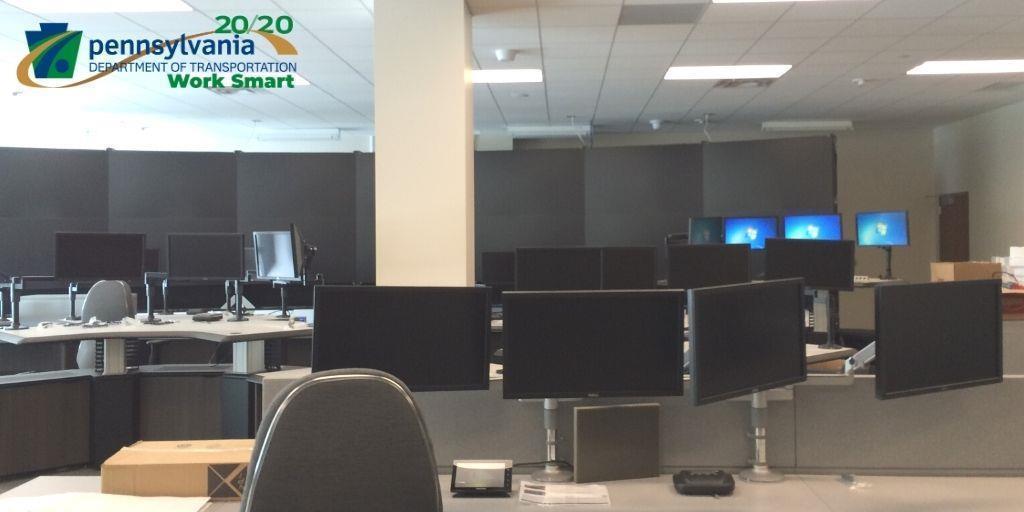
When the pandemic hit in March and many PennDOT employees began teleworking, District 8's Traffic Unit hit the ground running and never missed a step.
It just so happened that several years before, in 2012, the Traffic Unit started working diligently to reduce paper records, improve the electronic traffic study and permit review process as well as trying to embrace telecommunication technology.
By the time COVID-19 affected Pennsylvania, not only could they maintain productivity, they were able to provide guidance to other district traffic units in issuing electronic permit plans.
"Chris is our resident expert on electronic solutions, so we work smarter," said Jason Bewley, P.E., the district traffic engineer.
According to Bewley, Flad's philosophy that "everyone is important" helps create "a culture of positivity and system ownership." He added that it also encourages "independent thinking and innovation."
Specifically, under Flad's direction, the traffic unit:
- Developed a process for electronic signatures and professional engineer seals. They also trained other staff statewide on this process.
- Moved to an all-electronic submission system for traffic studies and traffic signal permits. The original goal was to reduce paper usage and the physical space required to manage the documents, but it also improved customer service by shortening and simplifying the entire permit process.
- Began using teleconferencing technologies for some internal meetings with consultants. The meetings were easier to schedule once travel time was eliminated from the process.
- As the quality of scanners improved and server-based storage became more affordable, staffers began digitizing existing paper records, such as traffic studies and permits. Not only were the paper files taking up physical space, but they were susceptible to destructive elements, such as water damage and deterioration. Electronic files are also more accessible, allowing for quick access to data, even in remote environments.
Another great success during the past six months, Flad said, was the transition of the District's Traffic Management Center (TMC) to a telework environment. The District 8 TMC routinely covers District 8 roadways 24/7, but also Districts 4 and 5 during nights and weekends.
With the help of necessary equipment, which IT quickly delivered, TMC operators in every district were able to perform essential functions, maintain critical operations and manage traffic operations without missing a beat.
"We continue to adjust as necessary to adapt to the changing times," Flad said. "Our sustained success in maximizing customer value and minimizing waste is a testament to those dedicated, hard-working individuals in the District."
As a result of the district's quick thinking and swift technological response, Christopher Flad and his team will be given a 2020 Innovation Award.
District 8 shared this smart practice through PennDOT WorkSmart, an online system, accessible 24/7, that provides all PennDOT employees with a forum to share their smart practices, or things they are already doing as part of their normal work day, with their fellow PennDOT employees.
PennDOT WorkSmart is administered by PennDOT's Bureau of Innovations (BOI). For more information, contact DOTInnovations@pa.gov.
ABOUT THIS BLOG
Did you know PennDOT is directly responsible for nearly 40,000 miles of highway and roughly 25,000 bridges? We oversee programs and policies affecting highways, urban and rural public transportation, airports, railroads, ports and waterways, in addition to administering the state's more than 11 million vehicle registrations and 8.8 million driver's licenses.
So, how do we do what we do? And how can we help you travel in Pennsylvania — whether it be for business or leisure — in safe and enjoyable manner? Read PennDOT Way to learn more about the department, what we do, and how and why we do it.
TAGS
50-Year Anniversary, 511PA, Aggressive Driving, Airports, Autonomous Vehicles, Bicycles, Bridges, Child Safety, Community Relations, Construction, COVID-19, Distracted Driving, District 1, District 10, District 11, District 12, District 2, District 3, District 4, District 5, District 6, District 8, District 9, DOTcom, Driver and Vehicle Services, Emergency Responders, Employment, Equity, FAQ Friday, Human Trafficking, Impaired Driving, Innovations, Live Free Ride Alive, Maintenance Monday, Motorcycles, Older Drivers, PA Motorcycle Safety Program, Pedestrians, PennDOT Connects, Ports, Public Transit, Railroads, REAL ID, Road MaP, Roadside Beautification, Rural Roads, Safety, School Buses, Seat Belts, State Transportation Innovation Council (STIC), Sustainability, Teen Drivers, Throwback Thursday, Transportation Funding, Travel in PA, Welcome Centers, Winter, Work Smart, Work Zone, Yellow Dot
LATEST POSTS
PennDOT Continues Sharing, Updating Resources for Local Governments to Pursue Bipartisan Infrastructure Law Funding Opportunities
Norwin High School Wins 2024 ‘Innovations Challenge’
Demo Complete: I-95 CAP Project in Center City Philadelphia
PennDOT Archeologist Connects Past, Present, and Future
Lehigh Valley DUI, Highway Safety Task Force Hosts Law Enforcement Seminar
ARCHIVES
2024
2023
2022
2021
2020
2019
2018
2017

